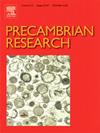受多矿物岩石年代学约束的新元古代高压麻粒岩变质时间尺度——以巴西东南部Brasília造山带南部为例
IF 3.2
2区 地球科学
Q2 GEOSCIENCES, MULTIDISCIPLINARY
引用次数: 0
摘要
通过多矿物岩石年代学对Carvalhos Klippe (Brasília南造山带)新元古代高压麻粒岩的时间尺度进行了约束。高变质作用与西冈瓦纳拼合时期的大陆碰撞过程有关,对新元古代碰撞环境的持续时间和速率提供了有价值的见解。根据相平衡模型和金红石中锆的测温结果,大多数被研究的样品包括粗粒金红石-蓝晶石-石榴石-正长石麻粒岩,变质峰条件为~ 825°C和12 kbar。高y - ree和低Th/U独居石域的石榴石Lu-Hf和U- pb年龄限制了其向近峰值阶段(630-620 Ma)的发展。低Y-HREE,高Th/U和Eu/Eu*独居石域记录了大量石榴石生长、熔体存在和斜长石消耗后的变质峰(615-605 Ma)。在605 ~ 600 Ma的逆行过程中,以高Y-HREE、高Th/U和贫Eu/Eu*独居石域为主要特征,反映了石榴石的溶解和熔融结晶。锆石年龄主要集中在630 ~ 605 Ma之间,很可能与近峰值冷却有关。金红石、磷灰石U-Pb和黑云母Rb-Sr的冷却年龄在570 - 540 Ma之间,表明在逆行过程中冷却速度较慢,为2-8°C/Myr,与现代碰撞造山带相比,这是由于地幔温度较高或侵蚀速率和/或产热元素浓度较低。这项研究表明,高压麻粒岩的时间尺度可以为理解整个地球历史上的大陆环境提供一个强有力的框架。本文章由计算机程序翻译,如有差异,请以英文原文为准。
Metamorphic timescales of Neoproterozoic high-pressure granulites constrained by multi-mineral petrochronology: A case study from the Southern Brasília Orogen (SE Brazil)
Timescales of Neoproterozoic high-pressure granulites from the Carvalhos Klippe (Southern Brasília Orogen) were constrained through multi-mineral petrochronology. The high-grade metamorphism is related to continental collision processes during the assembly of West Gondwana and provides valuable insights on duration and rates of collisional settings in the Neoproterozoic. Most of the investigated samples comprises coarse-grained rutile-kyanite-garnet-orthoclase granulites, reaching peak metamorphic conditions of ∼ 825 °C and 12 kbar, based on phase equilibrium modelling and Zr-in-rutile thermometry. Prograde to a near peak stage (630–620 Ma) was constrained by garnet Lu-Hf and U-Pb ages from high Y-HREE and low Th/U monazite domains. Low Y-HREE, high Th/U and Eu/Eu* monazite domains record the metamorphic peak (615–605 Ma) after substantial garnet growth, presence of melt and plagioclase consumption. The retrograde stage highlighted by high Y-HREE and Th/U and depleted Eu/Eu* monazite domains, reflects garnet dissolution and melt crystallization during the retrograde path (605–600 Ma). Zircon ages have a main cluster between 630 and 605 Ma, most likely related to near-peak cooling. Cooling ages obtained by rutile and apatite U-Pb and biotite Rb-Sr ranging from 570 to 540 Ma suggest slow cooling rates of 2–8 °C/Myr during the retrograde path, contrasting with the modern collisional orogens due to hotter mantle temperatures or low erosion rate and/or heat-producing elements concentration. This study demonstrates that the timescales of high-pressure granulites may provide a robust framework for understanding continental settings throughout the Earth’s history.
求助全文
通过发布文献求助,成功后即可免费获取论文全文。
去求助
来源期刊

Precambrian Research
地学-地球科学综合
CiteScore
7.20
自引率
28.90%
发文量
325
审稿时长
12 months
期刊介绍:
Precambrian Research publishes studies on all aspects of the early stages of the composition, structure and evolution of the Earth and its planetary neighbours. With a focus on process-oriented and comparative studies, it covers, but is not restricted to, subjects such as:
(1) Chemical, biological, biochemical and cosmochemical evolution; the origin of life; the evolution of the oceans and atmosphere; the early fossil record; palaeobiology;
(2) Geochronology and isotope and elemental geochemistry;
(3) Precambrian mineral deposits;
(4) Geophysical aspects of the early Earth and Precambrian terrains;
(5) Nature, formation and evolution of the Precambrian lithosphere and mantle including magmatic, depositional, metamorphic and tectonic processes.
In addition, the editors particularly welcome integrated process-oriented studies that involve a combination of the above fields and comparative studies that demonstrate the effect of Precambrian evolution on Phanerozoic earth system processes.
Regional and localised studies of Precambrian phenomena are considered appropriate only when the detail and quality allow illustration of a wider process, or when significant gaps in basic knowledge of a particular area can be filled.
 求助内容:
求助内容: 应助结果提醒方式:
应助结果提醒方式:


